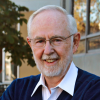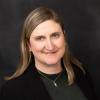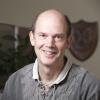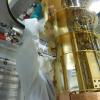Dark Matter
Underground research unlocking knowledge about the particles that make up galaxies
November 29, 2023
Share

The 12-metre diameter acrylic SNO+ detector is filled with 780 tonnes of liquid scintillator and surrounded by 10,000 photomultiplier light detectors. Queen's Art of Research Submission: "The SNO+ Detector" by Dr. Alex Wright, Faculty (Physics, Engineering Physics, and Astronomy) for the SNO+ Collaboration, SNOLAB.
It inspires some of the largest, most ambitious and collaborative research endeavours of our time: the hunt for dark matter. Theorists, experimentalists and technologists push for insights on dark matter in the quest to understand the gravitational forces that hold galaxies together and probe the evolution of our universe.
Taking a prominent position among the leading efforts that span the globe – from Chicago to Geneva to Tokai, Japan – are Canadian teams associated with the Arthur B. McDonald Astroparticle Physics Research Institute (McDonald Institute) and SNOLAB, which gained initial renown through the Sudbury Neutrino (SNO) experiment, a scientific discovery that shook long-held foundations of knowledge.
"The work that was done in the two experiments for which the Nobel Prize was awarded – our measurement with solar neutrinos and the measurement in Japan with neutrinos produced in the atmosphere – have defined new properties of neutrinos," says Arthur McDonald, 2015 Nobel Prize in Physics Laureate and Gray Chair Emeritus, Department of Physics, Queen’s University. "This has led to heightened interest in neutrinos, the first particles to require an extension of the Standard Model."
According to the Standard Model of elementary particles, neutrinos were previously assumed to be stable and unchanging in their properties once they’re created, a theory the SNO project disproved by showing that these elusive but fundamental particles oscillate from one flavour into another – and therefore must have mass.
The resulting international acclaim contributed to a snowball effect that saw SNO transform from a single-experiment site to SNOLAB, a facility attracting significant international collaboration, according to Dr. McDonald. SNOLAB, constructed by Carleton University, is administered by a consortium of five Canadian universities, with major responsibilities for Queen’s.
Demonstrating our ability to work deep underground in an ultra-clean laboratory with minimum radioactivity brought a significant reputational increase to the point where the world is paying attention. SNOLAB has become the go-to place for underground astroparticle physics experiments.
– Arthur McDonald
2015 Nobel Physics Laureate and Gray Chair Emeritus, Queen's University


There are currently 23 experiments in various stages of development at SNOLAB, which boasts a 5,000-square-metre underground clean room.
The lab
What makes SNOLAB uniquely suited to investigations involving neutrinos and dark matter – which require a highly controlled environment and sensitive detectors – is its location two kilometres underground in Vale’s Creighton mine in Ontario and its ultra-clean environment.
"SNOLAB is the lowest radioactivity underground laboratory in the world, with its only competitor being a new laboratory in China," says Dr. McDonald. "Our detectors would effectively glow like the Northern Lights if we weren’t suppressing [cosmic radiation] by a factor of more than a million through the rock above us."
Over the past decade, funding support allowed SNOLAB to significantly expand laboratory facilities and research capabilities, says Jodi Cooley, Queen’s professor of physics, who assumed the role of SNOLAB’s executive director last year and who previously worked with Takaaki Kajita and the Japanese team who shared the Nobel Prize with Dr. McDonald.
A recent strategic plan maps out SNOLAB’s ambition to be "the leading international laboratory for deep underground science – and to host the world’s most advanced experiments that provide insights into the nature of the universe," she says. "That’s a big vision, but we’re already known for our leadership in underground research in Canada and across the world."
"There are currently 23 experiments in various stages of development at SNOLAB, which boasts a 5,000-square-metre underground clean room, with the largest cavern being 10 storeys tall – and another one measuring 15 by 15 metres," says Dr. Cooley.
"International collaborations bring Canadian scientists and students into contact with the world," says Dr. McDonald. “They also bring economic advantages to Canada due to the substantial contributions made by international partners to these experiments.”
We have over 1,000 academic users and collaborators from 24 different countries and 164 different institutions associated with the lab. And 25 per cent of the researchers are Canadian.
– Jodi Cooley
Executive Director, SNOLAB and Professor, Physics, Engineering Physics, and Astronomy, Queen's University

The science
Across the globe, "and notably at the Fermilab in Chicago, at CERN in Geneva and JPARC in Tokai, there are a number of significant experiments underway to advance our understanding of the properties of neutrinos and the search for dark matter particles," says Dr. McDonald. "What we do at SNOLAB is very complementary to these efforts."
For theoretical discoveries in physical cosmology, Canadian theorist Jim Peebles received the Nobel Prize in 2019, and Dr. McDonald credits him with "developing a theory that helps us understand how the universe has evolved since the Big Bang."
"However, it requires dark matter in the quantities we observe through gravity," he says. "We know that dark matter particles are necessary – and we know, at the very least, that they are completely different from anything we know so far."
"Much of what we’ve learned about dark matter currently comes from astronomical observation," explains Dr. Cooley. "We understand a lot about the gravitational interaction of dark matter from observing its effect on galaxies and stars. And based on our models of particle physics, we have some good ideas of how we think it should interact with ordinary matter."
Yet such interactions are difficult to study since dark matter is non-luminous (i.e., it can’t be seen on any light spectrum) – and it doesn’t interact via the strong or electromagnetic force, she says. "This inspires experiments to see whether dark matter interacts via the weak force, the force that allows nuclear decay."
We are working very hard to bring the world to Canada – to work with Canadians.
– Tony Noble
Scientific Director, McDonald Institute and Professor, Physics, Engineering Physics, and Astronomy, Queen's University

The experiments
Dark matter experiments at SNOLAB – and other international facilities – involve "placing ordinary matter in a detector," says Dr. McDonald. "The idea is to observe dark matter interacting with one of the atoms in these materials so we can say, 'Aha, this was a dark matter particle!'"
Detecting the previously undetectable requires innovative approaches, he suggests. For the SuperCDMS experiment now being installed, for example, silicon and germanium crystals are arranged in towers and connected to highly sensitive electronics that monitor data. In addition, the array is placed in an extremely low-temperature environment 0.015 degrees above absolute zero, enabling measurements of minute temperature rise from dark matter interactions.
"SuperCDMS is a $50-million undertaking with substantial Canadian participation as well as considerable financing coming from outside Canada," says Dr. McDonald.
Another experiment, DEAP-3600, uses liquid argon with the idea that an interaction with dark matter can produce a very short burst of light in the range of nanoseconds, much shorter than signals from radioactivity. Yet another investigation, PICO, takes place in a bubble chamber, where dark matter interactions create bubbles – different from most radioactivity.
More insights on dark matter particles are expected to be gained through the study of neutrinos, and SNOLAB hosts the SNO+ project, which builds on the work that led to Dr. McDonald’s Nobel Prize, as well as HALO (Helium and Lead Observatory), which is part of the international SNEWS (Neutrinos and the SuperNova Early Warning System) project.
“Several of our experiments are waiting for the next supernova in our galaxy, so we can study the neutrinos from this explosion,” says Dr. Cooley. Since neutrinos will reach the Earth before the light or other matter resulting from the supernova, an early alert will allow scientists to triangulate the location of the star and maximize the potential to collect photons and additional information about the event.
Other SNOLAB programs include environmental monitoring and studies of the effects of radiation on biological systems and on quantum technologies.

Data from the detectors is transferred to lab computers through a temperature cooling process. [Credit: Jonathan Corbett]

Dr. Peter Skensved is the only person to ever access the top of the acrylic SNO+ detector in order to perform a small modification to its surface. [Credit: Dr. Mark Chen]
The outcomes
SNOLAB’s research excellence has inspired expressions of interest from the international community, “indicating the facility allows for the best conditions for a range of experiments,” says Tony Noble, professor of physics at Queen’s University and scientific director of the McDonald Institute. “We are working very hard to bring the world to Canada – to work with Canadians.”
Advancing world-leading science requires more than a facility housing the experiments, and that’s where the McDonald Institute provides crucial academic, engineering and technical resources to “integrate and support this research,” states Dr. Noble. “For example, people are working on the design of next-generation dark matter detectors, where sensitivity is increased by an order of magnitude.”
Next-generation experiments will likely involve hundreds of collaborators from across the globe and cost hundreds of millions of dollars, he says. “Since it is important for Canada to be a major participant, we are working to advance key concepts, attract funding support and train highly qualified personnel: the experts who will work alongside their international peers.”
Collaborating with globally recognized leaders requires – as well as builds – impressive skills “in analysis, critical thinking, computing and other activities at the cutting edge of technology,” says Dr. Noble. “We find that the Canadian experts working at SNOLAB are highly sought after. Some of them go on to work in academia or national labs; others go into industry or create their own startups.”
Expertise gained in the lab’s ultra-low-radioactivity environment has inspired many innovations, including in areas like water purification, material science and medical diagnostic technologies, he explains. “Since the techniques we’re developing allow us to look for very faint signals and detect rare things, this can be very useful in medical imaging, for example, in nuclear magnetic resonance or positron emission tomography [PET] scans.”
PET scanners use technologies that were developed for particle physics detectors, and Dr. Noble envisions progressively more sensitive equipment making a difference for patients, with "lower doses of radiation leading to less tissue damage."
Given the tremendous potential SNOLAB and McDonald Institute-supported experiments represent for Canada – and a proven impact both in and beyond astroparticle physics research – Dr. McDonald advocates for strengthening a talent pipeline that can support "the people who will enhance the quality of Canadian scientific and technical capabilities in the future using the evidence-based decision-making that they have learned."
"We have substantial programs and outreach to the general public and particularly young Canadians with an interest in science, technology, engineering and math," he says. "We are also committed to advancing equity, diversity and inclusion – with a strong focus on reducing barriers for Indigenous people."
Taken together, these efforts can help "maintain the momentum we have gained in this field," he adds.
Dr. Cooley agrees, "I hope Canadians have an appreciation for how unique it is to have this laboratory that has been built on the vision of the collaborative Canadian scientific community. We’re looking for insights into the universe’s biggest unanswered questions, and I hope for another discovery at SNOLAB to earn us another Nobel Prize."



